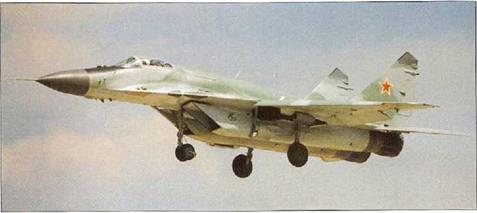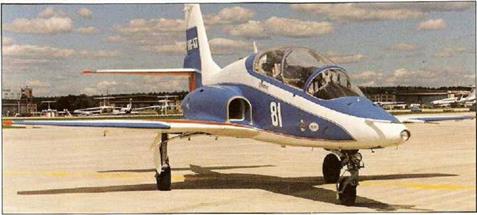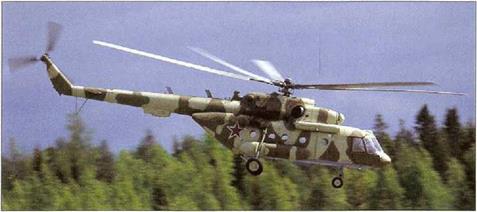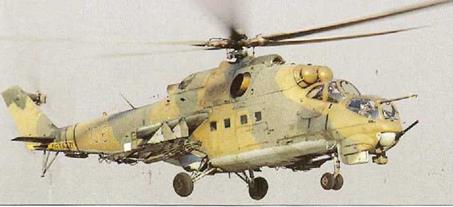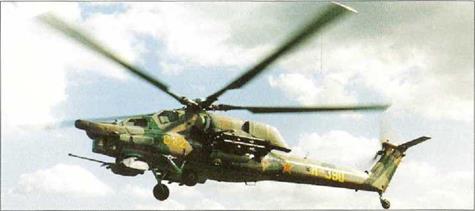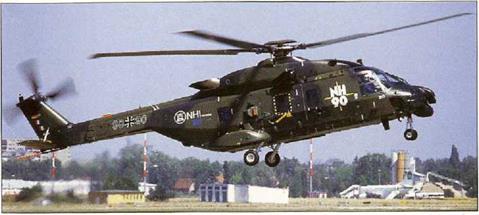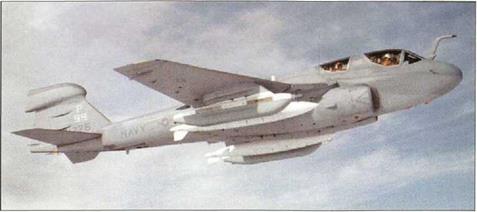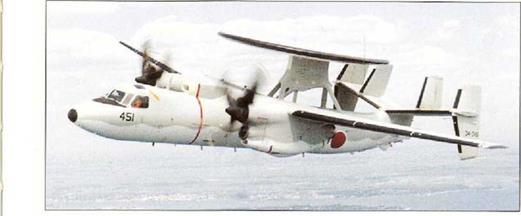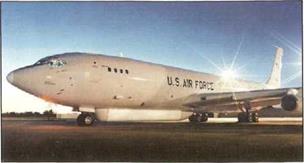Mikoyan MiG-29 ‘Fulcrum
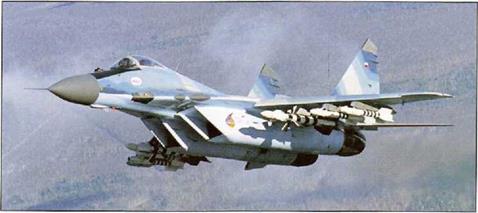
|
T |
he MiG-29 (NATO code-name ‘Fulcrum’) was developed to meet a 1971 requirement for a lightweight fighter to replace Frontal Aviation MiG-21 s, MiG-23s and Su-17s in the battlefield air superiority and ground – attack roles. Design work began in 1974, and the first prototype flew on 6 October 1977, Deliveries began in 1983.
The baseline MiG-29 ‘Fulcrum-A’ carries two BVR AA-10 ‘Alamo-As’ inboard and four short-range AA-8 ‘Aphid’ or AA-11 ‘Archer’ IR-homing missiles outboard, backed by an internal 30-mm cannon. Early Russian MiG-29 regiments included a ‘strike’ squadron, its aircraft using the 30-kT RN-4Q nuclear weapon on the port inboard pylon, The MiG-29 has an N-019 pulse-Doppler radar and a passive IRST sysiem. This can detect, track and engage a target while leaving the radar in a non-emitting mode. For close-in engagements, a helmet-mounted sight can be used to cue IR-homing missiles onto an off-bore – sight target.
More than 450 single-seat ‘Fulcrums’ are estimated to be in service with the WS, and other former Soviet states including Belarus, Kazakhstan. Moldova, Turkmenistan, Ukraine and Uzbekistan. The aircraft has also been acquired by Bangladesh, Bulgaria, Cuba, Czech Republic, East Germany, West Germany, Hungary, India, Iran, Iraq, North Korea, Malaysia, Peru, Poiend, Romania, Slovakia, South Yemen, Syria and Yugoslavia. MiG-29s have been evaluated by Israel and by the USA.
The MiG-28SE demonstrator was based on the ‘fat back’ ‘Fulcrum-C’ and was intended as an improved export version of the first-generation MiG-29.
The MiG-29UB (9-51) ‘Fulcrum-B’ trainer has no radar, but retains the IRST and has a weapons system simulator, allowing the instructor to generate HUD, IRST and radar symbology in the front cockpit. An improved single-seater HVIodel 9-13, known to NATO as the ‘Fulcrum-C’) introduced a bulged spine, housing additional fuel and an active jammer. None have been exported outside the former USSR, except a handful of Moldovan aircraft supplied to the USA.
MiG-293, SD, SE and SM designations were applied to planned late production variants and upgrade configurations, while the MiG-29M (9-15) was an advanced derivative with revised structure, increased fuel and genuine multi-role capability. This reached the prototype stage, as did the carrier – borne MrG-29K (9-31) . A handful of MiG-29S aircraft entered service with Russian regiments, and the SD formed the basis of the MiG-29N for Malaysia. A number of upgrade programmes are underway in Germany (DASA), Romania (Aerostar Sniper) and Russia itself,
The Luftwaffe’s ‘Fu/crum-Asinherited from the former East German air force, have been overhauled by DASA to make them more reliable and economic.
|


Russia
Enhanced multi-role combat aircraft
|
|
T |
ne first attempt to produce a ‘second-generation’ muiti-role MiG-29 resulted in the MiG-29M (9.15). six prototypes of which were constructed and flown from April 1986. This featured a redes;gned airframe, with deleted overwing intake ducts and with extensive use of composites and advanced welded aluminium-lithium alloy components, giving increased internal volume with the minimum weight penalty. The aircraft aiso featured aerodynamic refinements, including ‘sharp’ LERXes and increased spar ailerons. The ai’craft also had a revised weapons system, with RLPK-29M (N010) Zhuk radar, and new TV and laser guidance systems for PGMs. The aircraft impressed during acceptance trials, but cid not enter production, due to the high, cost of re-tooling. Two prototypes of a carrierborne derivative, the MiG-29K (9.31) were also built, with an increased span, reduced-sweep folding wing and extenced chord flaps, drooping ai erons and enlarged tailp anes. Development ceased in 1992, after the less versatile Su-27K was selected for Russia’s carrier.
Instead of procuring a new-build second-generation MiG-29, it was eventually deciced to produce such an aircraft by upgrading existing MiG-29s. The MiG-29SMT (9.17) can be manufactured using
existing jigs, or produced by upgrade. It has a new glass cockpit, and new multi role avionics, and has a massive swollen spine to provide the necessary extra internal fuel capacity. This covers the old ‘spl’t-beaver tail’ airbrakes, and requTes the addition o* a large dorsa airbrake, like that used on the MiG-29M. Tne aircraft also features a bolt-on retractable refueling probe and has an extra pair of uncerwing harcpoints. The airframe is strengthened to allow ooeraiior at much higher weights, and has an extended airframe life. An avionics prototype first flew on 29 November 1997, and an aircraft with a mock-up of the new spine followed on 22 April 1998. A fully converted prototype flew on 14 July 1998. Current plans call for about 180 Russian air force MiG-29s to be upgraded to SMT standard. This includes the two-seat MiG-29UBT version, which car also be configured for a combat role.
The MiG-29SMT forms the oasis of s new can erborne version (using the MiG-29K’s wing, landing gear anc other navalised features) known as the MiG-29SMTK A further sub-variant, the MiG-29MTK or IVMG-29K-2002 offers fold ng tailplanes and a narrow-span ‘nboard wng fold, and has been offered to India to equip the newly – acquired ar. d converted carrier Gorshkov.
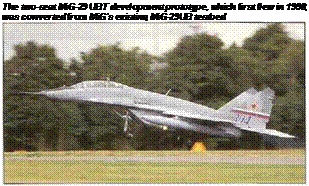 Specification: Mikoyan MiG-29SMT Powerplant: planned to receive two SB 1 kN (22,050-lb) Klim ov/L эп і ng rad RD-933 (RD-43) turbofans
Specification: Mikoyan MiG-29SMT Powerplant: planned to receive two SB 1 kN (22,050-lb) Klim ov/L эп і ng rad RD-933 (RD-43) turbofans
Dimensions: wing span 11.36 nn (37 3!4in|: length 17.32 m (56 ft 10 in); height 4.73 n (15 ft 6.2 in)
Weights: maximum take-off 71,100 kg (46,237 lb) in ground attack configuration Performance: maximum level speed 2445 krnii (1,519 mph); maximum rale sf climb st sea level 19800 m |64,90". ft) per minute; service ceiling 17000 n (55,775 ft); ferry range 3500 km [2,7)4 miles): combs* radius 1550 km (963 miles) Armament: one GSn-301 30-nvr cannon, p us 5000-icg (11,023-lb) of ordnance
Russia
Long-range heavy interceptor
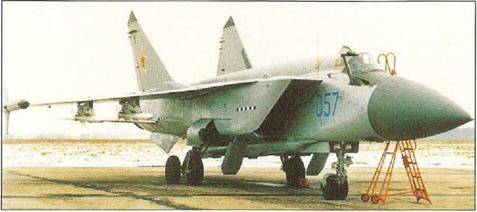
|
T |
he MiG-31 ‘Foxhound’ was ceve oped to counter the threat Dosed by new low-level strike aircraft and cruise missiles, complementing the Su-27 in service, and us ng its ultra-long-range capability to fill gaps in Russia’s ground-based radar cha:n. A two-seat derivative of the MiG-25 ’Foxbat’ airframe, the ‘Foxhound’ introduced an ai – new structure, a new wing planform with small LERXes, Soloviev D-30F-6 turbofans and a new undercarriage. The Ye-155MP prototype flew on 16 September 1975 and series probuct’or of 280 fvliG-31s began in 1979.
The MiG-31 featured a flat belly with four missi e recesses for its orimary armament, which consisted of R-33 (AA-9 ’Amos’) AAMs. The ‘Foxhound’ also carries a scafcbed-on GSh-6-23 six-barrel ed 23-mm cannon ooo and has underwing pylons for two AA-6 ‘Acrid’ or four AA-8 ‘Aphid’ missiles. The new ‘Zaslon’ radar had a pnased-array antenna, increasing range and allowing faster, more accurate beam pointing. Ten targets can be tracked simultaneously, and four engaged. Groups of four IVliG-31s can operate independently of ground control, covering a 900-km (560-mile) swathe of territory, with tne leader automatically controlling his wingmen,
The MiG-31 01-DZ introduced a retractable inflight refuel ing probe, whi e the MiG-31 В also had an improved radar with better ECCM, and a new digital processor, Existing aircraft brought up to the same standard were designated MiG-31 BS
This is one of the improved MiG-31 development aircraft, identifiable by its wingtip fairings. It is carrying a load ofR-77 (AA-12 Adder’) missiles.
Two MiG-3 ID prototypes were produced as testbeds for a new anti-satellite missile. The MiG-31E, MiG-31 F and MiG-31FE designations were applied to unbui’t export ana upgrade configurations, while the MiG-31 BM s a proposed defence suppression variant,
The improved MiG-31M interceptor variart was oui t in prototype form only. The MiG-31 M carried six R-37 long-range AAMs in three side-by-side recesses under the belly, each accommodating tandem pairs of missiles. Its new radar hac a 1.4-m diameter antenna anc could simultaneously engage six targets. A fully-retractable IRST was fitted, and MiG-31 Ms also have a redesigned rear cockpit, with three CRT MFDs. Other changes include a one-piece carooy and windscreen, a retractable IFR probe, large wingtip ESM pods, and aerodynamic refinements. Redesigned LERXes improved high AoA handling, and a bulged spire gave increased fuel caoacity, but development was abandoned due to lack of funding. The first of six prototypes made its maiden flight on 21 December 1985.
This Foxhound’ is the one-off MiG-31 LL flying testbed, operated by the Lll flight test and development institute, atZhukhovskii.
|

Russia
Basic and advanced trainer, light attack aircraft
|
|
D |
uring the late 1980s MiG began design work on a new type of advanced trainer. The Russian а;г force had an emerging requirement to replace its Czech-built L-29 and L-39 jet trainers and opened up the search for the new aircraft to Russian industry. Submissions from Sukhoi and Myasischev were rejected, but the MiG-АТ proposal was selected to go forward with the Yakovlev Yak-130 for evaluation.
The MiG-АТ was a more conventional design than the Yak-130, using a low-wing configuration, mid-set tailplane and over-wing inlets for its Turbomeca-SNECMA Larzac turbofans. The original design featured a ‘T-taiT and the PS/ZMK DV-2 (R-35! engine, but these elans were abandoned – as was an intended industrial co-operation with Korea’s Daewoo.
In addition to its French-supplied engines the MiG-АТ also features French-supplied cockpit avionics, from Sextant and Thomson-CSF (now Thales). Each cockpit is fitted with a pair of colour multi-function displays and provision for helmet – mounted sights, while the front cockpit had a wide- angle HUD for the student. MiG designed the MiG-АТ to have a re-configurable three-axis digital flight control system, allowing the aircraft to
Development and acquisition funding for the MiG-AT have been hard to come by in recent years, as post Cold War military budget cuts have bitten deeply.
replicate the handling characteristics of a number of different front-l ne combat types.
MiG has proposed two versions of the basic trainer, the MiG-ATR for Russian air force service (with Russian engines and avionics) and the export MiG-ATF with Sextant Topflight avionics. The MiG-ATR would be powered by the Soyuz/CIAM RD-1700 engine wnich is currently under development. The MiG-ATS (or MiG-AT-UTS) is a combat – capable/weapons training version, fitted with underwing hardpoints end a centreline stores station. The second MiG-AT prototype was built to this standard. MiG is also proposing a dedicated light-attack variant, the single-seat MiG-AS, with a built-in gun, radar and air-to-air missiles.
The first MiG-AT made its official maiden flight on 21 March 1996. The MiG-AT is being adopted by the Russian air force, though Yakovlev claims to have received air force orders for the Yak-130 also. Russia has a requirement for between 200 and 250 MliG-ATs, and MiG is building an initial batch of 18 aircraft, the MiG-AT is also being promoted on the export market – most recently in South. Africa and India. In both cases it was beaten by the BAE SYSTEMS Hawk, but MiG is optimistic that the MiG-AT will find new customers.
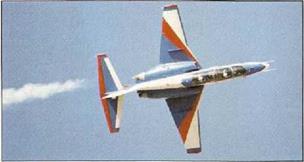
|
|
|
M |
il’s Mi-8 (NATO code-name ‘Hip’) helicopter was designed as a turbine-engined Mil Mi-4 derivative, using the same tailboom and rotors. The new Isotov turboshaft was relocated above the fuselage, allowing a simpler transmission and bigger cabin for up to 28 troops. The single-engined prototype V-8 ‘Hip-A’ flew during 1961, followed by the V-8 ‘Hip-B’, powered by twin TV2 engines, The Mi-8P ‘Hip-C’ was a transport, while the Mi-85 Salon was в passenger/VIP transport with toilet and galley, and square cabin windows The МЇ-8Т/АТ ‘Hip-C’ is a utility transport with circular cabin windows, and optional outriggers cauying four weapons pylons. The МІ-8ТВ ‘Hip-E’ is a dedicated assault derivative, with a nose – mounted machine-gun. It has new outriggers with three underslung nylons per side. Above the outer four pylons are launch rails for the AT-2 ‘Swatter’ ATGM. The export МІ-8ТВК ‘Hip-F’ had six ‘over – wing’ launch rails for the AT-3 ‘Sagger’ ATGM. To improve performance, the Mi-8 was re-engined with uprated TV3-117MTs to produce the Mi-17 ‘Hip-H’. The new aircraft has PZU intake filters, anc the tail rotor is relocated from starbosrd to port. CiS/Russian air forces use the Mil МІ-8МТ or Mi-8TV designations depending on equipment fit.
The ‘Нір-D’ was a command post/radio relay platform, with a pair of tubular antennas above the rear fuselage, and a V-shaped antenna mast under the tailboom. The Mi-9 ‘Hip-G’ is another command
post/radio relay variant, with ‘hockey stick1 antennas under the tailboom. The Mi-8SMV ‘Hip-J’ operates in the ECM jamming role. The Mil МЇ-8РРА ‘Hip-K’ is a communications jammer, with box fairings on the fuselage sides, a complex mesh-on-tubular – framework antenna array on the rear fuselage and six side-by-side neat exchangers below the forward fuselage. The МІ-17Р or МІ-17РР ‘Hip-H (EW)’ has the same heat exchangers and box-like fairings on the fuselage sides but has a solid array in place of the mesh antenna.
Since the break-up of the Soviet Union, the pants building Mii helicopters have begun marketing their own versions. These include Kazan, Ulan Ude and the Mil Moscow Helicopter Plant. Ulan Ude has offered an export Mi-17 with Western avionics ca led the Mi-171 and also the Mi-8AMT(Sh) ‘Terminator’ which has a four hardpoint stub wing. Kazan’s main version is the Mi-8TV-3 (similar to the ‘Terminator’, With the Mi-172 as the export version. Kazan a so makes the Mi-17MD with a rear loading ramp and capacity increased to 40 passengers.
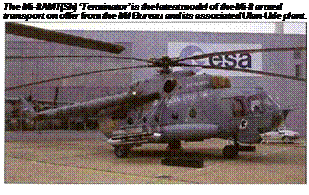 Specification: Mil Mi-B "Hip-C’ Powerplant: two 125/-kW(1,700-hp) Klimov (Isotov) TV2-117 A turboshefts Dimensions: rolyr diameter 21.29 m (69 ft 1014 in); length overall, rotors turning 25.2-5 m (82 ft 9K in) and fuselage 18 "7 m {59 ft 7.35 in); height overall 5.65 n (18 It 52 in)
Specification: Mil Mi-B "Hip-C’ Powerplant: two 125/-kW(1,700-hp) Klimov (Isotov) TV2-117 A turboshefts Dimensions: rolyr diameter 21.29 m (69 ft 1014 in); length overall, rotors turning 25.2-5 m (82 ft 9K in) and fuselage 18 "7 m {59 ft 7.35 in); height overall 5.65 n (18 It 52 in)
Weights: tyoical empty 7260 kg (16.007 lb); maximum payload 4000 kg 18,8′ 3 lb); maximum take-oil 12000 kg (26.455 lb);
Performance: maximum level speed 2БС kinh (161 mph); muximLm cruising speed 225 kmh (140 mph); sendee ceiling 4500 m (14760 It); hovering cei ng 1500 m (6.235 ft) IGE and 800 m (2,525 III OGt; ferry range 1200 km (746 milesl; range 465 km 1259 miles), standard fuel
|
|
T |
he Mil Mi-24 ‘Hind’ wss developed from the Mi-8, using the same engines and rotor, It was designed as a flying ARC, to carry soldiers and provide its own suppressive fire, while relyirg on speed lor protection. A V-24 prototype flew in 1970 and the production ‘Hind-A’ entered service during 1973, armed with АЇ-2 ‘Swatter’ missiles. During production the TV3-117 engine (used by the Mi-17) was introduced, leading to repositioning of the tail rotor to the port side of the tailboom.
The Mi-24’s anti-tank capability became more important, but the original heavily-gla2ed cockpit provided inadequate visibility and little protection. The solution was en entirely new nose, with separate, stepped, heavily armoured tandem cockpits for the pilot (rear) and gunner (front). Under the nose was a stabilised turret housing a four-barreiled 12.7-mm gun. The new aircraft was the Mi-24D ‘Hind-D’ iMi-25 for export). This was soon replaced by the MI-24V ‘Hind-E’ (Mi-35 for export) armed with tube-launched AT-6 ‘Spiral’ missile.
Combat experience in Afghanistan proved that the Mi-24 was a sound design. However, the original 12.7-mm machine-gun proved ineffective against some targets, and the ‘Hind’ needed a bigger gun. Accordingly, Mil designed the МІ-24Р ‘Hind-F’
whicn mounts a GSh-ЗОК twin-barrelled 30-mm cannon on the starboard forward fuselage. This was followed by the Mi-24VP, armed with the smaller twin-barrelled GSh-23L 23-mm cannon in its nose turret. Export versions of the ‘Hind-F’ were designated МІ-25Р and МІ-35Р Over 35 countries, most recently Macedonia, have taken delivery of Hind’ variants and they have seen combat in numerous conflicts, including Ethiopia-Eritrea, Nicaragua, Sri Lanka, and various parts of the former Soviet Union, notably Chechnya.
The МЇ-24М is an upgraded night-capable version for the Russian forces with the rotor and transmission system of the Mi-28 and a turret for a twin 23-mm cannon. This is offered for export as the Mi-35M, while the Russian army has gone for a less sophisticated Mi-24VM with new avionics. A second phase will see the Mi-28 rotor/transmission introduced, as well as a lightweight fixed undercarriage. Israel’s Tamam (a division of IA!) and South Africa’s ATE have offered upgrades with western avionics and weapons capabilities. ATE’s ‘Super Hind’ has a 20-mm chain gun cannon and new night vision systems. The first ‘Super Hind’ customer is Algeria, while the Tamam upgrade is thought to encompass 25 Mi -25s for India,
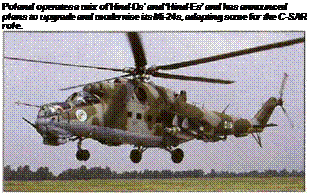 Specification: Mil Mi-24D ‘Hind-D’ PowerpSant: two 1640-kW {2,200-hp) Klimov (Isotov) TV3-117 Senes III turboshafts Dimensions: main rater dameter 17.30 ni (55 ft 9 in|, length cverall, rotors turning 19.79 nn (64 ft 11 n) and ‘fuselage 17.51 m (57 ft 57 ir) excluding rotors and gun; heigh overall 6.50 n (21 ft 4 ini with rotors turning Weights: empty 8400 kg (18.519 b); тэх:тит take-off 12500 kg (27,557 lb] Performance: maximum level speed 310 krnh (192 mph), service ceiling 4500 m (14,765 It); combat radius 160 km (99 miles) with maximum military load
Specification: Mil Mi-24D ‘Hind-D’ PowerpSant: two 1640-kW {2,200-hp) Klimov (Isotov) TV3-117 Senes III turboshafts Dimensions: main rater dameter 17.30 ni (55 ft 9 in|, length cverall, rotors turning 19.79 nn (64 ft 11 n) and ‘fuselage 17.51 m (57 ft 57 ir) excluding rotors and gun; heigh overall 6.50 n (21 ft 4 ini with rotors turning Weights: empty 8400 kg (18.519 b); тэх:тит take-off 12500 kg (27,557 lb] Performance: maximum level speed 310 krnh (192 mph), service ceiling 4500 m (14,765 It); combat radius 160 km (99 miles) with maximum military load
Armament: one four-barrelled JakB 12.7-mni gun, maximum ordnance 2400 kg (5.201 lb)
Russia
Multi-role combat helicopter
|
|
M |
il’s Mi-28 (NATO code-nams ‘Havoc’) is a successor to the Mi-24 and a direct rival to the Kamov Ka-50, Born in the Soviet era, the post Cold War years have seen funding for new p’-ograrrmes collapse and the Mi-28’s progress has been slow. The first of three Mi-28 attack hel copter prototypes flew on 10 November 1982. The basic production – standard МІ-28А flew in 1987 and was first seen in the West at the 1989 Paris Air Show. Since then it has not entered production.
The Mi-28’s conventional layout has stepped armoured cockpits accommodating a pilot (rear) and gunner (forward), with an undernose cannon. A conventional three-bladed tail rotor was abandoned and replaced on the second and third prototypes by a ‘scissor’-type tail rotor, with two independent two-bladed rotors on the same shaft, set at approximately 35° to each other and forming a narrow X.
The Mi-28 is armed with a single-barrelled 2A42 30-mm cannon, with twin 150-round ammunition boxes co-mounted to traverse, elevate and depress with the gun itself, reducing the likelihood of jamming. The stub wings have four pylons, each able to carry 480 kg (1.058 lb), typically consisting of four tube – launched AT-6 ‘Spiral’ missiles or a variety of rocket pods. The wingtip houses a chaff/flare dispenser.
The cockpit is covered by flat, non-glint panels of armoured glass, and is protected by titanium and ceramic armour. Vital components are protected and duplicated, and shielded by less important
items. In the event of a catastrophic hit the crew are protected by energy absorbing seats. An emergency escape system is installed which blows off the doors and inflates air bladders on the fuselage sides. The crew ‘oil over these before pulling their parachute ripcords.
Mil’s development effort has now movec on to the radar-equipped МІ-28ІМ all-weather day/night attack helicopter. This aircraft is fitted with a mast – mounted Kinzhal V or Arbalet millimetre-wave radar, like that of the Longbow Apache, with FUR and LLLTV sensors in the nose. The Mi-28N has an NVG-compatible cockpit with multi-function displays. Only four Mi-28s have been completed to date and they have undergone numerous detail changes. The first Mi-28N demonstrator was modified from the МІ-28А prototype. It had its formal roll out in August 1996 and first fiew on 30 April 1997. The names Night Hunter and Night Pirate have been applied to the Mi-28N, by Mil. Officially, the Russian army has adopted the Ka-50. but Mi-28N development continues.
 Specification: Mil МІ-28А Havoc" Powerplant: two 1640-kW (2,200-hp) Klimov (Isotpv) TV3-117VMA turbcshafts Dimensions: main rotor diameter 17.20 m ІВЄ it 5 in); wing span 4.87 m (16 ft); length oveiral. rotors turning 1915 m (62 ft 10 in) and fuselage 16.85 m (66 T37 in)
Specification: Mil МІ-28А Havoc" Powerplant: two 1640-kW (2,200-hp) Klimov (Isotpv) TV3-117VMA turbcshafts Dimensions: main rotor diameter 17.20 m ІВЄ it 5 in); wing span 4.87 m (16 ft); length oveiral. rotors turning 1915 m (62 ft 10 in) and fuselage 16.85 m (66 T37 in)
Weights: empty 8095 kg [17,046 lb); maximum lake-all 11500 kg (25.353 lb) Performance: maximum level speed 300 kmn (188 mph); service ceiling 5800 m (19,025 ft); hovering coiling 3500m (11,810 ft) 0GE; range 470 km (292 miles), endurance 2 hours Armament: one single-barrelled 2A42 30-mm cannon with two 150-round drums, maximum ordnance approximately 1920 kg (4,233 lb)
Japan
![]() Multi-role combat aircraft
Multi-role combat aircraft
|
|
J |
aoan has established a Tradition of military self – sufficiency, preferring to licence-build or indigenously develop its military hardware, despite the higher financial costs that such small-scale production ineviraoly Incurs. When the JASDF launched its FS-X competition to find a replacement for its attack-dedicated Mitsubishi F1s – and ultimately its upgraded F-4EJs – the solution came in an interesting hybrid, Japan decided to adopt a modified F-16C, redesigned in conjunction with Lockheed Martin and built by Mitsubishi (with Kawasaki, Fuji and Lockheed Martin as important sub-contractors). The new aircraft was given the designation F-2 Mitsubishi modified the F-16 by adding an entirely new, and larger, composite materials wing, a longer mid-fuselage, wider tailplanes, a slightly elongated nose and a brake-chute housing. The F-2 is powered by a General Electric F110 IPE turbofan, It is fitted with a Mitsubishi Electric active phased array radar, and a cockpit with LCD MFDs and a wide-angle holographic HUD – all of Japanese origin. A new integrated EW system has also been developed by Mitsubishi.
The Mitsubishi proposal was selected as the winning FS-X design in October 1987 and Mitsubishi was appointed as the prime contractor
in November 1988. After some early difficulties with the allocation of workshare and technology transfer between the US and Japan were ironed out, the initial airframe development contract was awarded in March 1989.
Mitsubishi has built four flying prototypes – two single-seat XF-2As and two two-seat XF-2Bs. The first prototype XF-2A made its maiden flight on 7 October 1995 and the first XF-2B flew on 17 April 1996. In May 1996 the Japanese government approved the production of 130 aircraft, comprising 83 F-2As and 47 F-2B trainers (and, at the same time, officially allocated the F-2 designation).
On 22 March 1996 the first XF-2A was handed over to the Japan Defence Agency. The XF-2 test fleet was transferred to the Air Development and Test Wing at Gifu AB. During 1998/99 serious problems were uncovered when the composite wing began to show signs of cracking when carrying heavy loads. This caused a nine-month delay in the programme while the wingtips and pylon attachments were redesigned. Mitsubishi delivered the first production F-2A aircraft to the Japan Defence Agency in a ceremony at its Komaki-South facility in September 2000. By the end of March 2001, 18 F-2s had been delivered to the JDA.
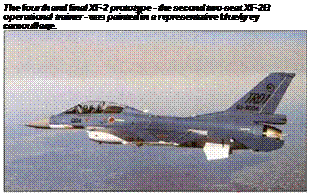 Specification: Mitsubishi F-2A Powerplant one 131.7-kN (29,BOO-lb) General Electrjn F110-GE-129 IPE afterburning turbofan (licence-built by I HI)
Specification: Mitsubishi F-2A Powerplant one 131.7-kN (29,BOO-lb) General Electrjn F110-GE-129 IPE afterburning turbofan (licence-built by I HI)
Dimensions: wing span 1113m (16 ft 6!* in), aver missile rails; length 15,52 m{50 ft11 in); height 4.96 m (16 ft 371 in)
Weights: empty, eqL pped 12QD0 kg (25,155 lb), maximum take-off 22Ю0 kg (48.722 lb) Performance: maximum level speed approximately Mach 2.0 IDetailed performance figures not available) Armament: one internal M61A1 Vulcan 20-mm cannon, plus 13 external stores stations
China Tactical bomber
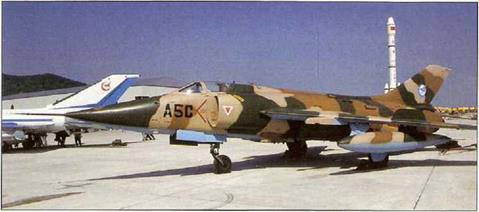
|
D |
evelopment of the Nanchang Q-5 ‘Fantan’ began in 1958 to meet a PLA requirement for a dedicatee attack aircraft. Although based on the MiG-19, Nanchang’s design retained only tne rear fuselage and main undercarriage, introducing a new, stretched, area-ruled fuseiage with an internal weapons bay, new conical-section nose, wings of greater area and less sweep, larger tailplanes and lateral air intakes. A prototype made its delayed maiden flight on 4 June 1965, but extensive modifications proved necessary to solve problems with the hydraulics, brakes, fuel and weapons systems. Two new prototypes flew in October 1969 and the type was ordered mto production.
Little is known about the dedicated Q-5A tactical nuclear strike version, which carries a single 5- to 20-kT free-fall bomb. The Q-51 is an extended-range variant with a new ejection seat, two additional hardpoints and a new Wopen WP6 engine. Some Q-5ls were modified to serve as missile-carriers with the PLA navy, and some of these may have Doppler nose radar. C-801 anti-ship missiles and torpedoes could also be carried. The Q-5IA, certified for production in 1985, was fitted with an additional underwing hardpoini and introduced a new gun/bomb sighting system and new defensive avionics. Thep-511 received an RWR but was otherwise similar. The A-5C (Q-5IIII was an export Q-5IA for Pakistan with substantially improved avionics and compatibility with AIM-9 AAMs. The A-5Cs
The A-5C Is still on offer to export customers, but its bargain-basement price brings with it outdated technology and debatable effectiveness.
serve with two squadrons at Peshawar, one having been disbanded due to the high accident rate. A programme to rebuild A-5Cs in Pakistan has beer •Liming out refurbished aircraft at about 10 per year for very low cost compared to new-build examples.
Production of the Q-5/A-5 continues by Hongdu Aviation Industry Group (HAIG) – which Nanchang became in 1998 – though only at a low rate as attrition replacements. Over 1,000 are believed to have been delivered. Approximately 500 Q-5s serve with 12 regiments of the PLAAF.
The A-5 has been exported to Bangladesh, North Korea, Pakistan and Myanmar (Burma). Several programmes were launched to upgrade Q-5s with Western avionics and/or equipment. The A-5K Kong Yun (Cloud) was equipped with a French-built laser rangefinder The А-БМ programme began in conjunction with Italy and added a ranging radar, an INS, a HUD and new IFF and RWR equipment. An extra wing hardpoint was added, along with compatibility with the PL-5 AAM. All western-aided upgrade work on the A-5 has now ceased.
The PLAAF relies heavily on the 0-5 as Its primary tactical strike/attack aircraft It has no obvious successor in the Chinese inventory.
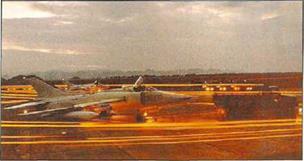 Specification: Nanchang Q-5 IA ‘Fantan’ Powerplant: two 39.7-kN (8,930-lb) Liming (LM) Wopen-6A afterburning turbojets Dimensions: wing span 9.58 m (31 It Э in), length 15.65 m (51 ft in) including probe, height 4,333 m (14 ft 2A in)
Specification: Nanchang Q-5 IA ‘Fantan’ Powerplant: two 39.7-kN (8,930-lb) Liming (LM) Wopen-6A afterburning turbojets Dimensions: wing span 9.58 m (31 It Э in), length 15.65 m (51 ft in) including probe, height 4,333 m (14 ft 2A in)
Weights, emoty 6375 kg (11,354 lb): rraxmum take-off 11830 kg I25.CB0 lb) Performance: maximum leve speed 1190 kmh (74C mph); maximum rate of climo at 5C00 m (16,400 ft) 4980-5180 m (16.340-20,275 ft) per minute; service ceiling 15850 m (52.030 ft); combat radius with maximum external stores. 400 km (248 miles!
Armament: two Type 23-2K 23-mm cannon with 100 rpg, plus 2000-kg (4,409-lb) ordnance
![]() Fran се / Germ a пу/ It а І у Advanced multi-role helicopter
Fran се / Germ a пу/ It а І у Advanced multi-role helicopter
|
|
A |
longside the EH101 the li H Industries NH 90 is the ‘most inportent European collaborative helicopter programme. In terms of planned production numbers it is certainly the largest. The NH 90 is being developed by a consortum of manufacturers from France, Germany, Italy and the Netherlands with Eurocopter and Agusta {now AgustaWestland) as the senior partners. Two versions, the multi-role raval NFH and the battlefield tactical transport TTH are being developed from a common airframe.
The NH 90 prog’amne can trace its beginnings back to the mid-1980s (its very name betrays the fact that was intended as a helicopter for th9 1990s). Tne first NATO ndustrial Advisory Group studies were aunched in 1983/84 and a five-nation Moll (including Britain) was signed in 1985. The initial design phase was launched in 1986, but in ‘.987 tne UK withdrew and the German and Italian work- shares had to be renegotiated n 1990/91. Further design and development VIoUs were finally signed in 1992, agreeing to the production of five flying prototypes – nearly 10 years after the NH90 programme began.
The NFH (NATO Frigate Helicopter) is desigred for ASW and ASuWjssks, with a secondary SAR and transoort role, he TTH (Tactical Transport
Helicopter! is an army/ar force version – or akmobi e operations. The twir-engined NH 90 will be the world’s firs: f:y-by-wire helicopter, using a quadruplex digital flight control system. The fuselage is built entirely from composite materials, as are the main ‘otor blades (which use an advanced aerofoil section with curved tios). The NFH cockpit has a five – screen EFIS layout, wnilethe TTH has four,
The first of the five NH 90 prototypes was bu It to a common basic configumtion and made its fhst Tght or 18 December ‘995, powered by RTM 322 engines. It flew with the NIT 90’s alternate T70Q powerplsnts n March 1998. The first full TTH missior system was f own n 1999 on the fourth prototype, while the first full NFH system flew later that year on the fifth prototype,
m June 2000 the partner nations gave the go – ahead for full NH 90 production. A month later, in July, they s gned a firm order for the first batch of 298 NH 90s, comprising 70 TTHs and 46 ~THs for Italy (plus one option), 27 NFHs for France, 80 TTHs for Germany (plus 54 options) and 20 NFHs for the Netherlands. The initial NH 90 production comrrri – ment is for 366 helicopters and the tota European requirement *or tne NH 90 stands at 595 aircraft The first (TTH) deliveries will begin in 2003.
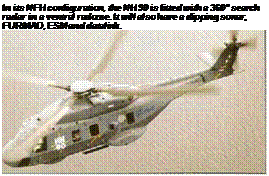 Specification: NH 90 TTH Powerplant: two 1253-<W*1.680-hoi class Ralls-Rayce/lirbomeca PTM372-01/9 or Alfa Rameo/6ET70C-T6E turboshafts Dimensions: rotor diameter 16.30 m (53 ft 5/ in): length overall, rotors turnirg 19 55 m (G4 ft 2 it) arid luseloge 15.89 m |57 ft 1/ it): height overall 5.44 m (‘7 ft 10 in)
Specification: NH 90 TTH Powerplant: two 1253-<W*1.680-hoi class Ralls-Rayce/lirbomeca PTM372-01/9 or Alfa Rameo/6ET70C-T6E turboshafts Dimensions: rotor diameter 16.30 m (53 ft 5/ in): length overall, rotors turnirg 19 55 m (G4 ft 2 it) arid luseloge 15.89 m |57 ft 1/ it): height overall 5.44 m (‘7 ft 10 in)
Weights: typical empty 54-30 kg (11.505 >b). mission payload 2500 ку {5.512 Ibl; maximum take-off 10000 xg (22,046 lb):
Performance: maximum erasing soeed 251 kmh (181 rrph); service celling 4250 m (13,840 ft); hovering ceiling 35CC m(11,480 ft) IGF and 2900 n (9.52C ftl 0GE; ^erry range 1204 km (748 miles); missinn radius 250 <m (’55 nilesl
|
|
D |
esigned and bu’lt for the US Navy, Grumman’s EA-6B Prowler is now the United States’ only dedicated lethal SEAD (Suppression o’ Enemy Air Defences} and IVgh-oerformance jamming glat’orm. Experience with the two-crew EA-6A EW aircraft led to the development o’ an advanced, lengthened four-seat A-6 variant, seating a oilot and three e ectronic warfare officers (EWOsl to manage the sophisticated smay of ECM ard ESM systems Entering service dining 1971, it introduced a tactical jamming system 0iS} which employs noise1 jamming originating from a maximum of five transmitter pods. The first 23 production aircraft were to ‘Basic’ standard with ALQ-99 TJS and ALQ-92 communications jamming system.
These were fo loweo in "I973 by 25 EXCAP (Expanded Capability} a’rframes witn the ALQ-99A TJS. in 1976, the ICAP (Improved Capability) standard was app iec to ^5 new-bui. d and 17 ea-lier aircraft and introduced new displays, AN/ALQ-126 multiple – band defensive treakers anc upcated raaa – deception gear, All 55 surviving ICAPs were upgraded with software and display improvements to ІСАР-І standam. This also introduces ungraded jamming pods and is able to handle groups of weapons systems with imoroved identification of hostile emitters and improved reliability and maintainability. The ICAP-ll/Block 86 introduced ‘hard kill’ canability with AGM-88A HARMs. More recently, EA 63s have been upgraded to two ADVCAP conf gurat;ors. The
basic ADVCAD has new jammer transmission and passive Detection capabilities and an expanded AK/ALE-39 chaff dispenser fit. An Avionics Improvement Pmgrarr was to lead to a remanufec – tured ADVCAP, Block 91 EA-6B with new displays, radar improvements, an imarcved tactica support jamming suite, AK/ALQ-K9 communications jamming system and a digital autop lot. In fact, only three prototypes were tested, and a new uograue, Block 86, proceeded instead. This inciucec new radios, a cig tal fue indicator ana other cockpit imo-ovements. All surviving aircraft then became Block 89, with new ‘safety of flight’ features such as halon fire extinguishers and hardened control rods, and were followed by Block 89A rebu;ds with imoroved instrumentation and imbedded GPS.
With tne retirement of the USAF’s F 4G ‘Wild Weasel’s and EF-111 jamming aircraft, a joint – service agreement allocated four Prowler squadrons to Air Fcrce use when needed. These units have a mix of USAF and USN crews and first saw action during Operation Allied Force in 1999.
In addition to the US Navy’s 16 Prowler squadrons, the US Marine Corps operates another four. This aircraft is from VMAQ-1 ‘Banshees’.
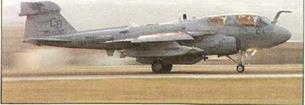 Specification; EA-6B Prowler Powcrplant; two 49.8-kN (11.200-0) Pratt & Whitney J52-P4CR turbojets Dimensions: wing span 16.1b n!53 fl); width folded 7.87 rr (25 ft 10 r$ length 18.24 m I59 ft 10 in); height 4.85 m (16 ft 3 in)
Specification; EA-6B Prowler Powcrplant; two 49.8-kN (11.200-0) Pratt & Whitney J52-P4CR turbojets Dimensions: wing span 16.1b n!53 fl); width folded 7.87 rr (25 ft 10 r$ length 18.24 m I59 ft 10 in); height 4.85 m (16 ft 3 in)
Weights: empty 1432′ kg (ЗІ,572 lb); normal carrier take-off 24/03 kg (54,461 1Ы. o’ from lard 27493 <g{6C, B1011:1 Performance: maximum level soeed with five jamnnrr pass 962 krnh {6:0 mph); service cel mg with five jammer pods’ 1Ь39 m (38,000 ft); rence 1769 km (1,099 miles! with maximum external load
Armament: up to four AGM-S8A HARM enti – rariar missiles
United States Long-range ‘stealth’ bomber
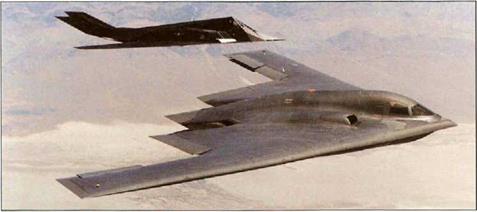
|
T |
he Northrop B-2 Spirit flying wing was developed in great secrecy as a ‘stealthy’, radar-evading, bomber for the Cold War mission of attacking Soviet targets with stand-off nuciear weapons. B-2 development was a ‘black’ programme, known in its infancy as Project Senior C. J. and later as the ATB {Advanced Technology Bomber)
The 8-2’s four F118 turbofans are non-afterburning variants of the F110 turbofan and have intakes and exhausts locatedabove the aircraft to shield them from detection. The crew/payload section of the aircraft starts aft of the apex of the wing, ends at the wing trailing edge and is smoothly blended on the upper surfaces of the wing. The crew compartment provides side-by-side seating for two pilots, seated in zero-zero ACES II ejection seats.
The first flight of a B-2 took place on 17 July 1989. Test flying to evaluate low observables technology began on 30 October 1990. The USAF received is first operational B-2 in December 1993 and the last was delivered to the 509th Bomb Wing at Whiteman AFB, MO in December 1997. As later aircraft were delivered, early examples were upgraded to Block 20 and Block 30 standard, Block 30 bombers have full PGM and terrain-following capability and improved stealth measures.
The B-2 has a nuclear strike role, armed with cruise missiles or bombs. This aircraft was involved in inert drop tests of the B61-11 penetrating nuclear bomb.
The B-2 used stealth technology developed a generation after the F-117 Stealth Fighter, and the differences between the two are striking.
Total procurement, reduced initially from 132 to 75, has been curtailed to just 20 front-line aircraft due to the enormous $2.25 billion cost of each B-2. The need for secrecy and problems with the Defensive Management System (DMS) contributed to the ballooning of costs. Maintenance costs are also very high due to the need to preserve the smooth, RAM-coated surface finish.
Although many observers thought that the USAF would never risk the costly B-2 in anything other than all-out nuclear war, the Spirit saw action against Yugoslav forces in Kosovo in 1999. Nonstop 15-hour missions were flown all the way from Whiteman to the Balkans and back, in which up to 16 GPS-guided 2.000-lb JDAMs were dropped on targets such as airfields and air defence sites with 16 direct hits, and complete surprise from the defenders The USAF plans to build special dedicated B-2 hangars at forward locations such as RAF Fairford, in the UK, to support future deployed operations and reduce the strain on aircrews from such extremely long missions. With possible charges to US defence strategy forthcoming, Northrop Grumman has offered to reopen the production line for an improved version at a cost of $700 million each for a batch buy.

|
|
|
T |
he E-2 Hawkeye has been the US Navy’s airborne early warning platform since entering service in 1964. It has a rotodome (mounted above the rear upper fuselage) housing antennas for the main radar and IFF systems. Including prototypes and development aircraft, a total of 59 E-2As was built, equipped with the APS-96 surveillance radar. Most were later converted to E-2B standard with a general-purpose computer and retired from service in the mid-1980s.
Current generation Hawkeyes are built to E-2C standard, the first example of which flew on 20 January 1971. Identified by a cooling intake behind the cockpit, the E-2C introduced a new APS-125 radar and improved signal processing capability. The basic E-2C has been the subject of continual updating over the years. Raoar units have changed to the APS-138 (E-2C Group 0), the APS-139 (E-2C Group I, from 1989) and the APS-145 (E-2C Group II) now fitted to all aircraft. APS-145 offers improved resistance to jamming and better overland surveillance capability.
Production of the Hawkeye by Grumman on Long Island finished in 1994 with the 139th example, but was reinstated at St. Augustine, Florida to turn out four Group II aircraft per year plus export aircraft. In the AEW role, the E-2C extends the detection range of the battle group by about 480 km (300 miles) for aircraft and 258 km (160 miles) for cruise missiles. Small surface vessels can be located
at 231 km (143 miles). Communication is maintained with the carrier’s Combat Information Centre and patrolling fighters by means of a datalink. The Hawkeye can also act as an airborne control and command post, feeding directions to attack aircraft and escorting fighters to deconflict them, in addition to providing warnings of hostile aircraft.
In US Navy service, the E-2C flies with 11 active – duty units, two training units and two Reserve squadrons. E-2Cs have been exported to the air forces of Egypt (six), Japan (13). Singapore (four plus two on option) and Taiwan (four E-2Ts>. Israel had four aircraft fitted with refuelling probes but has now retired them. The French navy is acquiring four E-2Cs to operate from its new carrier, Charles De Gaulle.
The next-generation Hawkeye 2000 will integrate into the USN’s Co-operative Engagement Capability network. Northrop Grumman also has plans for an Advanced Hawkeye with a new multi- bladed propeller and a tactical cockpit giving the pilots access to the overall sensor ‘picture’
 Specification: Grumman E-2C Hawkeye
Specification: Grumman E-2C Hawkeye
Po we гр I a n t two 3661 – kW (4.910-hp) Allison T58-A-425 turbuprops
Dimensions: wing span 24.56 m (80 ft 7 in): folded width 8.94 m{29 ft 4 in); length 17,54 m (57 ft in); height 5 58 m (18 ft VA in) Weights: empty 1728b kg (38,063 lb); maximum lake-off 23556 kg (51.933 lb) Performance: maximum level speed 598 kmh (372 mphl; maximum rate of climb at sea level 767 m (2.515 It) per minute; service ceiling 9390 m (30.800 ft); minimum take-off run 610 m (2,000 ft), minimum landing run 439 m (1,440 ft). 1,605 miles]; operational radius 320 km (200 miles) for a petrol of 3 to 4 hours
*U. S. AIR FORCE
|
M |
aking a ‘star’ appearance in Operation Desert Storm years before it was truly operational, the Boeing/Grumman E-8 represents a major advance in battlefield command and control, introducing the capaoility for monitoring and controlling the land battle that the E-3 provices in the air batt e.
і wo E-8A prototypes were converted from former Boeing 707 airliners, with the first flying in operational configuration in 22 December 1988. The E-8A had a cabin configured with 10 operator consoles. It introduced the Norden AN/APY-3 multi – mode side-looking phased array radar (housed in a forward ventral canoe fairing). Its synthetic aperture radar gives a high resolution radar picture out to 257 km (160 miles) from the orbiting aircraft, wh le two pulse-Doppler modes provide moving target indication (MTl).
A wide area search MTl mode monitors a large sector of land, while an MTl sector search mode is used to target smaller areas of inte’est to follow individual vehicles. The antenna can be electronically slewed 120° to either side of the aircraft to cover nearly 50,000 km’ (19,305 sq miles) and the radar has some capability to detect helicopters, rotating antennas and low slow-moving fixed wing aircraft. A dataiink is used to transmit intelligence gathered
A former Southern Air Transport Boeing 707 was used to provide the first full-scale development E-8C aircraft, which will serve as a permanent testbed.
in near rea – time to mobile ground consoles, similar to those on the E-8. Using the various modes, the JSTARS (Joint Surveillance Target Attack Radar
System) can be used for general surveillance and battlefield monitoring to provide the ‘big picture’ to commanders, stand-off radar reconnaissance or individual targeting functions for attacking vehicles and convoys.
In January 1991 both E-8As deployed to Riyadh to fly combat missions in Desert Storm. Forty-nine war missions were flown, for a total of 535 hours, a sizeable portion of which was spent on the search for Iraqi ‘Scud’ missiles.
In service, the JSTARS system was to have been carried on the new-build E-8B aircraft with F108 (CFM56) turbofans but, despite one YE-8B being procured (later sold), the production-standard platform is the E-8C based on converted 707 airliner airframes. The first production E-8C end a pre-production aircraft made their operational debut over Bosnia in 1996, but IOC with the 93rd Air Control Wing was not declared until December 1997. The E-8C crew consists of four flight crew and 18 operators. Current plans are for 14 E-8Cs to be in service by 2003. The USAF is already working on the RTIP radar upgrade for the JSTARS.
|
|
|
|
United States Lightweight fighter
|
|
I |
n 1954 the US government initiated a study for a simple lightweight fighter to be supplied via the Military Assistance Program. Northrop’s private – venture N-156C design made its first flight on 30 July 1959, and was selected in 1962 by the USAF as the required FX’ fighter. It was designated F-5, and an F-5A prototype flew in May 1963. A corresponding two-seat F-5B trainer entered service in April 1964, four months ahead of the F-5A. Northrop also developed the reconnaissance RF-5A, equipped with four nose-mounted cameras.
First generation F-5s were exported to Brazil, Greece, Jordan, Morocco, Philippines, Saudi Arabia, South Korea, Spain, Thailand, Turkey, Venezuela and Yemen. Improved versions were built by Canadair as the CF-5A and CF-5D and were later upgraded by Bristol Aerospace. Some were iater sold to Botswana. The Royal Netherlands air force ordered 105 NF-5As with leading-edge manoeuvre flaps and Doppler radar.
The F-5E/F Tiger II incorporated uprated J85 engines, an integrated fire control system, additional fuel and a larger, modified wing with LERXes and manoeuvring flaps. The F-5E is the single-seat variant and was first flown on 11 August 1972. The combat – capabie F-5F trainer had a lengthened fuselage was first delivered to the USAF in 1973, to prepare the aircraft for foreign users. F-5E/Fs later served for aggressor training with the USAF until the late 1980s and still fly with the USN.
Some 1,300 F-5E/Fs were supplied to 20 air forces. Current operators are Bahrain, Botswana, Brazil, Chile, Honduras, Indonesia, Iran, Jordan, Kenya, Malaysia. Mexico, Morocco, Saudi Arabia, Singapore, South Korea. Sudan, Switzerland, Taiwan, Thailand. Tunisia, USN/USMC, Venezuela and Yemen. It was also built under licence in South Korea, Switzerland and Taiwan.
Many F-5 upgrade programmes are now available. Chile, Brazil, Indonesia, Singapore, Taiwan and Turkey have all modernised their aircraft with new radars, cockpit systems and weapons.
A specialised RF-5E Tigereye reconnaissance version, retaining full combat capability, first flew in 1978. A modified lengthened nose houses a single camera. This can be augmented by two interchangeable pallets, containing combinations of panoramic cameras and an IR linescanner. The RF-5E has been exported to Malaysia and Saudi Arabia Singapore Aerospace has converted some of its F-5Es to RF-5S configuration and others to RF-5E TigerGazers for Taiwan.
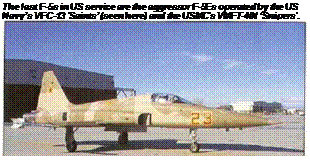 Specification: Northrop F-5E Tiger II Powerplant: two 22,24-kN (5,000-lb) General Electric J85-GE-21B afterburning turbojets Dimensions: wing span 8.53 m {28 ft) with tip-mounted MMs; length 14.45 m (47 ft 4K in! including probe; height 4.08 m {13 ft 4/ in| Weights: empty 4349 kg |9,558 IbJ; maximum take-off 11187 kg (24.664 lb)
Specification: Northrop F-5E Tiger II Powerplant: two 22,24-kN (5,000-lb) General Electric J85-GE-21B afterburning turbojets Dimensions: wing span 8.53 m {28 ft) with tip-mounted MMs; length 14.45 m (47 ft 4K in! including probe; height 4.08 m {13 ft 4/ in| Weights: empty 4349 kg |9,558 IbJ; maximum take-off 11187 kg (24.664 lb)
Performance: maximum level speed 17Э0 kmh I I,056 mph); maximum rate of climb at sea level 10455 m (34,300 ft) per minute; service ceiling 15590 m (51,800 ft); combat radius 1405 km (875 miles) with two AIM-9 AAMs Armament two M39A2 20-mm revolver cannon with 280 rounds per gun, maximum ordnance 3175 kg (7,000 lb) ~
United States











